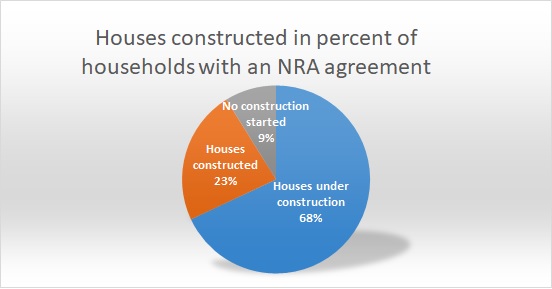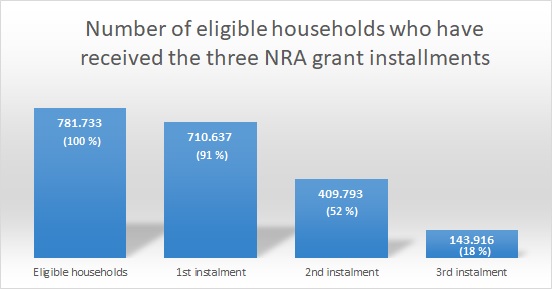The total number of households eligible for the NRA reconstruction grant is 781,733, and to be eligible, the household’s house must have been completely destroyed and it’s ownership formally documented. The eligible households are located mainly within the 14 worst affected districts, and by June 2018 719,232 of them had an NRA reconstruction grant agreement.
But how many of the eligible households had actually built a house by June 2018, three years after reconstruction started?
Well, the NRA reconstruction grant of 300,000 rs. is released in three installments. Most eligible households have received the first installment of 50,000 rs. but only 52 percent have made it to the second installment of 150,000 rs., which is released only when the foundation is approved. Most strikingly, just 18 percent have raised the third installment of 100,000 rs.!
The NRA reconstruction grant has so far resulted in the completion of 166,248 houses – around 55,000 a year. That’s the total! Close to 410,000 houses are undergoing some form of construction but how far they are to completion, or whether the houses are liveable, is not clear.
Only 166,248 houses have been completed in three years out of 781,733 eligible households. Source: NRA Reconstruction Progress Report, 18 June 2018.

Only 23 percent of the eligible households with an NRA agreement had completed a house by June 2018. Source: NRA Reconstruction Progress Report, 18 June 2018.
– Complex registration and application procedures. To apply for the grant, households need to produce a number of formal documents which are notoriously time-consuming to obtain; to get the installments, they need a bank account where banks are often far away; and engineers whose inspection is required in order to get the next installment are notoriously late.
– Political interference. The NRA itself but also registration of eligible households and grant distribution have been delayed by political bickering and manipulation.
– Vast household surveys. Several vast household surveys had to be made to determine and re-check the number and identity of eligible households. Complaints about political manipulation as well as unjustified exclusion from the NRA grant programme required major follow-up surveys.
– Lack of funds at the NRA. The international donor community, not least the Indian government, pledged billions of rupees in reconstruction aid but only some of these funds have actually reached the NRA bank account.
It’s also well-known that even 300,000 rs. – the total reconstruction grant, equivalent to 2,700 USD – is not a lot for building a house. The prices of building materials and masons keep rising. In Kavre district, one of the worst hit districts, building a new house easily costs 5-600,000 rs. Lack of money is a major reason why many households do not yet have a house!
Is the reconstruction process about to speed up? Well, the NRA just completed yet a survey to validate the eligibility of households in 57 local units. It took six months, involved 332 engineers and covered 130,000 households. Perhaps this will be the last one. With the number and identity of eligible households in place, at least this hurdle might no-longer cause delays.
But the NRA’s difficulties are only one thing. They pale in comparison to those of the affected households. Exposed to the elements when the shelter roof leaks or the sun heats up the tin shack, the practical difficulties are legion. Some take loans and go into debt to rebuild. Many elderly and women-headed households are faced with especially severe challenges.
Our thoughts go out to the still thousands of families who have to make it through a third monsoon in a temporary shelter. Hopefully, the reconstruction process will speed up once the rainy season is over and house construction can again start up. We’ll return with another update from the NRA Reconstruction Progress Report as soon as the next report is out!
Here are some recent quotes illustrating the complexity of the reconstruction process:
“The local politicians were targeting the [2017] elections. The more number of beneficiaries you can produce, the more votes.” Dr. Bhisma Bhusal, spokesperson for the NRA, on the reason why the number of beneficiaries under the NRA programme began to increase faster in 2017. Source.
“If people are going further into debt as a result of the earthquake, it poses longer-term questions about their life chances — whether their kids will be able to pursue and get a good education, and what that really meant for the families’ strategies.” Daniel Coyle, country director of People in Need, on consequences of a growing number of households taking loans to reconstruct their houses. Source.
“At a time when the male-headed households are unable to rebuild houses on time, the situation of single women, who have very limited or no support at all in rebuilding, is even worse.” Sumeera Shrestha, executive director at Women for Human Rights, Kathmandu. Source.
“Our only son is just 19. It’s not time for him to go abroad yet [as migrant worker, to send back money]. And so where will the money come from? I don’t sleep well at night, thinking ‘How will I pay my loan? How will I finish my house?'” Shyalmo Tamang, 62, Baaskharka village. Source.




